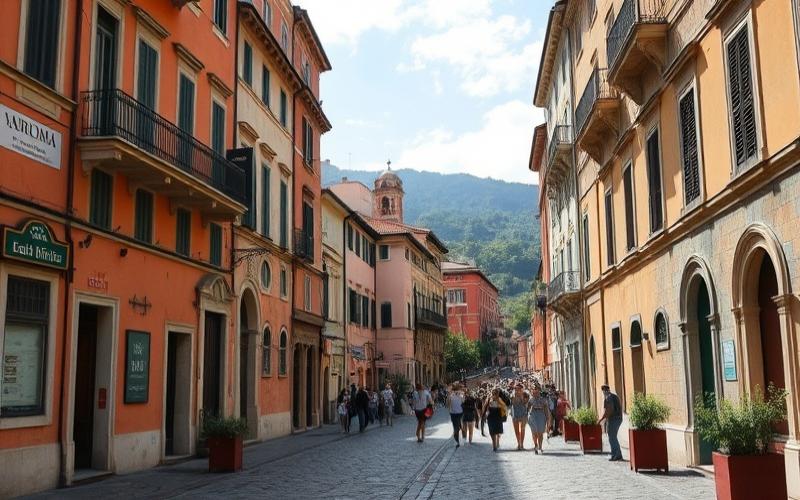
 Published on and written by Cyril Jarnias
Published on and written by Cyril Jarnias
With the Rise of Remote Work, Italy Attracts Digital Nomads
With the rise of remote work, Italy has become a popular destination for digital nomads, these itinerant workers who combine remote employment with cultural exploration.
A Notable Impact on the Rental Market
As they settle in Rome, Florence, and Milan, their presence is transforming the rental market landscape. The growing influx of these international professionals stimulates increased demand for flexible housing, leading to rising rents in some popular areas.
Good to know:
Cities like Rome, Florence, and Milan are experiencing an average 15% increase in rents in neighborhoods popular with digital nomads.
Opportunities and Challenges for the Italian Real Estate Market
However, this trend also brings various challenges, from local economic revitalization to potential saturation of the real estate market.
This article explores how the arrival of digital nomads is influencing the Italian rental market, revealing the opportunities and challenges it generates.
The Digital Nomad Phenomenon in Italy
Italy has become a popular destination for digital nomads thanks to the combination of a new digital nomad visa launched in 2024, high quality of life, fast internet infrastructure, and an urban ecosystem rich in culture, gastronomy, and flexible workspaces. 2025 rankings position it as a country offering high visa benefits, moderate cost of living, and sustained connectivity, which strengthens its appeal for remote workers.
Key Reasons for Attractiveness:
- Dedicated Visa (DNV): Italy formalized a digital nomad visa in 2024 requiring a minimum annual income of approximately €28,000, health insurance, and the possibility of partial tax exemptions for up to 5 years, facilitating legal settlement for non-EU remote workers.
- Quality of Life and Moderate Cost: 2025 indicators show “quality of life: high” and “cost of living: moderate,” with a strong overall score and good performance in innovation and tech.
- Digital Infrastructure: Internet speed ranked “high” and major cities well-equipped with coworking spaces, fiber, and 5G, crucial conditions for mobile professionals.
- Normalization of Remote Work: Global growth (50+ million nomads in 2025) amplifies demand for well-connected European destinations like Italy.
Flagship Cities and Their Assets for Nomads:
- Rome
- Connectivity and Coworking in central neighborhoods (Prati, Monti, Trastevere), access to 5G and international hubs, plus an endless cultural offering (museums, ancient sites) conducive to “work + culture.”
- Gastronomy: trattorias and markets (Testaccio, Campo de’ Fiori) fostering social life after work, with affordable options outside the hyper-center.
- Milan
- Economic and Tech Capital, excellent digital infrastructure, high-level coworking spaces, and international professional networks useful for freelancers and remote employees.
- Urban Quality: mobility, design, business events; higher rental costs but premium services.
- Florence
- Heritage Setting and Creative Scene attracting designers, marketers, creators; good connectivity for a medium-sized city and many “laptop-friendly” cafes.
- Pace of Life calmer than Milan/Rome, appreciated for medium-length stays.
- Naples
- Lower Cost of Living than major capitals and access to the sea, rise of coworking spaces, top-tier gastronomic scene; growing interest among nomads seeking authenticity and controlled budgets.
Impact on the Local Rental Market:
Changes in Prices and Availability
International demand fueled by the visa and hybrid work increases pressure on rents in central and well-connected neighborhoods of major cities; medium-length stays (1–6 months) encourage the conversion of furnished properties towards flexible rentals and “mid-term” leases.
Highly attractive cities (Milan, Rome, Florence) are seeing a decrease in availability of studios/1-bedroom apartments in tourist areas and near professional hubs, with demand shifting towards well-served suburbs.
Local Reactions and Tensions
Residents and associations worry about a displacement effect in certain neighborhoods and rising seasonal rents; conversely, property owners value stable income through “mid-term” contracts with solvent international tenants.
Property managers are moving towards “co-living” models and furnished shared housing, with services (cleaning, high-speed internet), to capture nomadic demand and smooth out seasonality.
Case Studies, Interviews, and Testimonials
2025 Nomad Profile
The global pool has surpassed 50 million, driven by visa policies and improved infrastructure; a significant portion holds remote salaried positions, which supports more stable demand for quality housing in Europe.
Synthetic Interviews
“Sofia, product designer (Buenos Aires → Milan, 6 months)”: chose Milan for the density of coworking spaces, ease of professional meetings, and reliable 5G; notes rising rents in Porta Garibaldi/Isola but found a co-living space with a flexible contract that included gigabit internet and shared offices.
“Arun, data analyst (Bangalore → Rome, 3 months)”: prioritized Rome for culture and compatible time zone; works from Prati with fiber; observes premium prices near the historic center, recommends neighborhoods on metro lines A/B for better value for money.
“Maya, content strategist (Toronto → Naples, 4 months)”: selected Naples for lower costs and gastronomy; good experience with coworking in the center; warns that availability of mid-term furnished rentals decreases in summer.
Owner/Manager Testimonials
A manager in Florence reports a more consistent occupancy rate thanks to 2–6 month stays by nomads, with few payment defaults, but higher turnover and need for digital services (keyless check-in, online billing).
An owner in Rome mentions adding high-speed internet and ergonomic desks to justify higher rents on transitional contracts aimed at the remote audience.
Public Policies and Local Initiatives
Digital Nomad Visa (DNV)
Italy formalized a nomad visa in 2024, requiring ~€28,000 in annual income, health insurance, and offering tax incentives that can go up to 50% tax exemption for 5 years depending on the profile, which lowers the initial setup cost for international talent.
In 2025, the country is ranked with strong visa benefits and a one-year duration with possibility of extension, pathway to permanent residence and reduced tax rate (mention of 15%) under incentive schemes, which strengthens regulatory predictability.
Local Programs
Deployment and promotion of co-living and coworking spaces in major cities to channel nomadic demand, encourage “mid-term” occupancy, and alleviate pressure on long-term leases.
Urban strategies focusing on connectivity (fiber/5G) and innovation, with a decent position in European “tech & innovation” rankings, useful for attracting talent and distributed companies.
Summary Table — Key Assets by City
| City | Digital Infrastructure | Gastronomic Scene | Quality of Life/Atmosphere | Observed Rental Effect |
|---|---|---|---|---|
| Rome | Extensive Fiber/5G, numerous coworking spaces | Trattorias, markets, varied options | Dense culture, lively neighborhoods | Upward pressure in center, shift towards mid-term |
| Milan | Very high level of infrastructure and coworking | Fine dining and street food | Business/tech dynamism | High rents, strong international demand |
| Florence | Good connectivity for a medium city | Tuscan cuisine, work-friendly cafes | Creative, heritage, calmer | Tension on furnished studios, success of co-living |
| Naples | Improving infrastructure, rising coworking spaces | Iconic cuisine, affordable costs | Authentic, maritime | More affordable alternative, marked seasonality |
Points of Attention for Decision-Makers
- Close monitoring of “mid-term” rents and furnished conversions.
- Incentives for creating dedicated co-living complexes to absorb demand without penalizing traditional residential supply.
- Continuous investment in fiber/5G and intermodality to expand attractive areas beyond hyper-centers.
- Clear communication on taxation and visa eligibility to avoid information asymmetry and windfall effects.
Useful Global Context Data
2025 Estimates: 40–80 million nomads, majority highly educated and early adopters of technology, which supports demand for “plug-and-play” housing with fast internet and included services.
Visa policies and infrastructure are the major drivers of this community’s growth, and Italy positions itself in the leading European pack regarding visa-related benefits.
Good to know:
Italy attracts many digital nomads due to its robust digital infrastructure, combined with a high quality of life, particularly in cities like Rome, Milan, Florence, and Naples which offer rich cultural heritage and an attractive gastronomic scene. This influx has caused a rise in rental prices and reduced housing availability, with owners turning towards often more lucrative short-term stays. Certain local policies, such as specific visas for remote workers and co-living programs, have been established to better integrate these new arrivals. Recent statistics show a 20% increase in rental prices in neighborhoods favored by digital nomads, while testimonials indicate general satisfaction regarding the welcome and local connections. Florence, for example, has set up co-working spaces in its historic areas to facilitate the integration of digital nomads.
The Appeal of Co-living Spaces for Digital Nomads
Digital nomads perceive co-living spaces in Italy as both community-oriented and operational housing solutions, reducing setup friction while offering flexible conditions adapted to remote work. This perception is reinforced by the presence of amenities designed for work, structured community activities, and pricing often more transparent than the private urban rental market.
Digital Infrastructure and Productivity
- High-speed internet connections, on-site coworking spaces, quiet rooms for calls, and “all-inclusive” services (cleaning, utilities, furniture) are key assets cited by co-living platforms and operators in Italy.
- “Ready-to-use” formats (private rooms, private bathrooms, equipped common spaces) eliminate transaction costs (energy contracts, furnishing), favoring rapid mobility for nomadic workers.
Networking Opportunities and Community Integration
- Co-living is presented as an explicitly “community” alternative to fragmented housing, fostering interaction, collaboration, and connections between similar international profiles (remote workers, freelancers).
- Activity programs (events, wellness, local exploration) structure the experience and strengthen social anchoring, particularly in destinations like Sardinia where the stay combines nature, productivity, and community life.
Flexibility of Rental Terms
- Monthly furnished rentals, individual leases, included charges, and shared/private room options offer superior flexibility compared to the traditional Italian market, often perceived as rigid and expensive in large cities.
- Temporary or seasonal projects (e.g., Tursi, Rotondella) show “cohort” offers at defined dates, useful for planning short work stays with immediate community immersion.
Key Cities and Demand Dynamics
- Urban hubs with strong expat and nomad communities include Milan, Rome, Florence, Turin, and Venice; secondary hubs exist in Bologna, Naples, Sicily, and Sardinia. These destinations concentrate the co-living supply listed by aggregators, signaling sustained demand for flexible stays.
- Initiatives in the Mezzogiorno (Basilicata, historic villages) seek to “revitalize” territories by attracting nomads via programmatic co-living, partially redistributing demand away from tense central markets.
Effects on Prices and Availability
- In already expensive large cities, the “all-inclusive” co-living positioning serves as a price anchor and can intensify competition in the short/medium-term furnished segments, increasing pressure on the local affordable supply, while it absorbs part of the nomadic demand outside the traditional stock when it involves dedicated buildings. According to nomad guides, the difficulty in finding affordable housing in urban centers reinforces the preference for flexible solutions like co-living, which supports demand and pricing for these products.
- In rural and island areas (e.g., Sardinia, Southern villages), the arrival of nomad stays in co-living stimulates seasonal demand and prices for furnished rentals, but can also diversify local income during the off-season via month-long stays and organized activities.
Specific Characteristics That Attract Digital Nomads
- Quality of the “bundle”:
- Reliable internet, dedicated workspaces, short leases, included charges.
- Community and Activities:
- Events, sports, wellness, cultural exploration, which structure the week and integration.
- Simplicity and Predictability:
- Selection and standardization via platforms, verification of roommates, individual contracts.
- Hybrid Location:
- Access to large cities for business and “nature” destinations for life balance, via timed programs.
Concrete Examples
- Sardinia: month-long stays combining work, outdoor activities, and local immersion, illustrating demand for productive environments outside metropolises, with community support.
- Basilicata (Tursi, Rotondella): cohort of digital nomads during specific slots (May-July), aiming to transform villages into temporary hubs, a sign of nomad flows towards less saturated areas.
- Metropolises (Milan, Rome, Florence): presence of expats and pro-nomad hostels; aggregators list dozens of co-living spaces, reflecting stable demand and increased competition in the flexible furnished segment.
Comparison of Housing Options for Digital Nomads in Italy
| Option | Strengths | Limitations | Suitable Profile |
|---|---|---|---|
| Co-living | Reliable internet, workspaces, community, flexible leases, included charges, private/shared rooms | “All-inclusive” cost sometimes higher than traditional shared housing; less privacy; community rules | Nomads seeking network, simplicity, and productivity |
| Classic Furnished Rental | Privacy and neighborhood choice; potentially better long-term cost | High deposits, less flexible contracts, utility setup, risk of inadequate internet | Long stays, budgets managing setup |
| Hostels/Hotels | Ultra-flexible, social (hostels), central location | Variable internet quality, no dedicated workspace, high nightly cost | Short stays, initial scouting |
| Airbnb/short-term rentals | Booking simplicity, kitchenette, variety | Wi‑Fi variability, service fees, dispersed standards | 1–4 week stays, priority on autonomy |
Nomad Perceptions and Trade-offs
- Co-living is seen as an optimal compromise between productivity and sociability: “community + Wi‑Fi + flexibility” trumps the sole search for low prices, especially in tense cities.
- Metropolises offer professional networks and services; rural/island co-living offers tranquility and nature with a community framework and events, attracting nomads seeking balance and authenticity.
Implications for the Local Rental Market
- In urban centers, the rise of flexible furnished offers and specialized operators can support rents in the short/medium-term segment, while channeling nomadic demand towards dedicated assets, partially limiting direct competition with traditional leases.
- In transitioning territories, co-living programs bring supplementary income and energize off-peak periods; the impact on prices depends on the scale of projects and substitution relative to existing seasonal rentals.
Elements to Monitor
- Standardization of the “nomad visa” and its administrative implementation, which can broaden the base of international demand towards Italy.
- Evolution of supply: rise of aggregators and dedicated operators listing dozens of assets in Italy, a sign of a structuring market.
Good to know:
Co-living spaces in Italy exert a strong attraction on digital nomads for several key reasons. They offer quality digital infrastructure, essential for remote work, as well as networking opportunities that foster professional exchanges. These spaces, present in cities like Milan, Rome, and Florence, respond to the growing demand from nomadic workers, influencing rising rental prices in these areas. The flexibility of rental terms, often monthly or weekly, perfectly adapts to the mobile lifestyle of digital nomads, contrasting with the rigid contracts of traditional rentals. For example, in Milan, the influx of these workers has led to a 15% increase in rents in neighborhoods popular for co-living. Unlike housing solutions like hotels or Airbnb, co-living spaces often offer more competitive rates and include shared services, making them a preferred option for their cost-effectiveness.
The Impact of Digital Nomads on the Italian Rental Market
The increase in the number of digital nomads boosts demand for short-term rentals (studios, furnished 1/2-bedroom apartments, co-living) in urban centers and well-connected tourist areas, while displacing part of the long-term supply towards better-paid flexible rentals, notably via monthly and seasonal stays. This pressure is particularly visible in cities offering good quality of life, reliable connectivity, and a favorable visa framework, parameters for which Italy is now competitively ranked for nomads (dedicated visa since 2024, high quality of life, fast internet).
Effects on Demand and Supply
- Increased demand for furnished housing with fast wifi, workspaces, and flexible contracts, responding to the preferences of a global pool estimated at 40–50+ million nomads in 2024–2025.
- Conversion of part of the long-term rental stock towards more profitable formats (monthly/short-term), particularly in central neighborhoods, UNESCO zones, and popular coastal areas.
- Strengthening of co-living/coworking ecosystems that aggregate furnished supply and reduce the availability of classic 4+4 leases in some micro-markets.
Influence on Rental Prices
- In large cities (Rome, Milan, Florence) and highly touristic destinations (Venice, Naples, Amalfi Coast, Puglia, Sicily), competition between nomads, long-term tourists, and remote managers supports rising furnished rents, especially for small, quality “ready-to-live” properties.
- Globally, the expected growth of nomads towards ~60 million by 2030 predicts sustained demand for these segments, which tends to maintain a price differential unfavorable to non-furnished long-term rentals in central neighborhoods.
Reactions of Local Residents
- Concerns regarding the scarcity of affordable housing and the “touristification” of historic neighborhoods, with perceived pressures on rents and neighborhood life.
- Expectations of measures to rebalance residential use and flexible stay rentals, particularly around historic centers and cultural hotspots.
Possible Measures by Italian Authorities
- Quotas or caps on nights for short-term rentals in certain urban perimeters; registration obligations and unique number for hosts; strengthened control of local taxation.
- Differentiated zoning: restrictions in historic centers and incentives for long-term in well-served peripheral neighborhoods.
- Minimum standards (safety, accessibility, noise) and data requirements (occupancy, average duration, seasonality) to guide housing policy.
- Incentive programs to return vacant or touristified housing to the long-term market (tax bonuses, rental guarantees).
- Coordination with the Italian nomad visa: Italy is ranked 17th globally for nomad attractiveness in 2025, with a 1-year, extendable visa, and a favorable tax framework; the visa-housing articulation can include declared address obligations and minimum stays favoring local stability.
Case Studies and Recent Indicators
- Size and dynamics of the pool: 40 million nomads estimated in 2024, with projection to 60 million by 2030, fueling demand in well-connected Southern European cities, including Italy.
- 2025 Growth: recent estimates place the global total beyond 50 million, reflecting more favorable visa policies and the normalization of remote work — a context that increases Italy’s appeal.
- Italy Attractiveness 2025: visa created in 2024, 1-year duration, possibility of extension, quality of life and internet “high,” announced flat tax of 15% under the scheme, and overall ranking 17th for nomads.
Table — Expected Effects by Segment and Area
| Zone/Segment | Long-term Availability | Short-term/Monthly Demand | Impact Furnished Rent | Impact Unfurnished Rent |
|---|---|---|---|---|
| Large Cities (Rome, Milan) | Decrease in central neighborhoods | Strong increase for furnished 1/2-bedroom | Marked increase | Moderate increase |
| Art Cities (Florence, Venice) | Net decrease (tourist pressure) | Very strong, seasonal | Strong increase | Moderate increase |
| Coastal/Island Destinations | Decrease in high season | Seasonal peak | Strong seasonal increase | Punctual increase |
| Well-connected Peripheries | Stable to slight decrease | Selective increase (co-living) | Slight increase | Stable |
Nomad Profiles and Purchasing Power
- Nomads are mostly qualified professionals, often salaried remote workers or freelancers; their concentration in Italian urban hubs strengthens demand for ready-to-use housing with services.
- The attractiveness of the Italian visa and quality of life increase the likelihood of medium-term installations (3–12 months), a segment that directly competes with traditional furnished leases.
Mitigation Avenues to Preserve Local Balance
- Density caps on listings per building/neighborhood; rules against wild change of use.
- Modulated tourist taxes and revenues directed towards affordable housing and transport.
- Public-private partnerships to develop regulated co-living with capped rents for international workers, to avoid cannibalization of the traditional residential stock.
Methodological Vigilance Points
Nomad population estimates vary: 40 million (2024) up to 50+ million (2025), depending on sources and counting methods; this uncertainty does not prevent the underlying trend of sustained growth affecting the most attractive Italian urban markets.
Quick Summary
- Demand: strong increase for flexible furnished in large cities and tourist areas.
- Supply: shift of part of the long-term towards short/monthly.
- Prices: furnished rents rising, especially small units and historic centers; unfurnished rents rising more moderately.
- Local reactions: concerns about accessibility and neighborhood cohesion.
- Public measures: quotas, registration, taxation, zoning, long-term incentives, coordination with the Italian nomad visa.
Good to know:
The influx of digital nomads to Italy has intensified demand for short-term rentals, particularly in large cities like Rome and Milan, as well as in popular tourist destinations such as Florence and Venice. This increased pressure has led to rising rents, with an average increase of 10 to 15% in some urban areas between 2021 and 2023. Local residents express growing concerns about these changes, with some being forced to seek more affordable housing in the periphery. To attempt to regulate this phenomenon and ensure balance, Italian authorities are considering implementing rent caps and promoting long-term rental housing for permanent residents. A 2022 study by the Italian Statistical Institute highlights that 60% of tourist-oriented owners now prefer flexible contracts to capture this new international clientele.
Challenges and Opportunities for the Real Estate Sector in Italy
Digital nomads in Italy stimulate rental demand oriented towards furnished, ready-to-live housing, with flexible leases (month-to-month or 3–6 months), reliable connectivity, and spaces adapted to remote work, which redefines quality and location criteria in well-connected cities with strong coworking scenes like Milan, Turin, or sunny Southern destinations. The introduction of the Italian visa for digital nomads, with income and health coverage requirements, facilitates longer stays, supporting more predictable and formal demand in the rental market.
Key Needs on the Demand Side
- Lease Flexibility: short renewable durations, fluid move-ins/outs, digital processes (signature, payments, remote inspections).
- Modernity of Infrastructure: high-speed fiber, reliable Wi‑Fi, nearby coworking spaces, ergonomic furniture (desk, chair), soundproofing and lighting for video calls.
- Location: central or well-served neighborhoods (train/airports), proximity to international communities and tech-creative ecosystems (Milan, Turin), or attractive and more affordable medium-sized cities (e.g., Puglia/Lecce, with vigilance on internet coverage).
- Included Services: utilities, cleaning, reactive maintenance, simplified bills, “all‑inclusive” options and smart home equipment.
Challenges for Owners and Agents
- Housing Standards: need to achieve “business ready” standards (guaranteed connectivity, professional furniture, security), with increased setup and maintenance costs.
- Turnover Management: more frequent turnover, digital check-in/out and customer service to implement, deposits/insurance adapted to medium stays.
- Tax and Regulatory Compliance: regulation of transitional vs. tourist leases, obligations related to visa and residence (traceability, contracts), and interactions with occupants’ local taxation.
- Location-Yield Trade-off: tension between expensive hyper-centers (Milan) and secondary cities offering better profitability but more nascent ecosystems (Turin, South).
Opportunities for the Sector
- Rise of Co‑living: formats with private rooms + shared spaces, community events and flexible subscriptions, particularly relevant in urban and university hubs.
- Lengthening of Average Stay Duration: the digital nomad visa secures stays of several months to a year, reducing vacancy compared to pure tourist accommodation.
- Segmentation and Premiumization: creation of “nomad‑ready” products (furniture/IT packs, multilingual customer service) and seasonal pricing policies by city/neighborhood.
- Tax and Regulatory Adaptation: clarification of medium-term rental statuses and procedures for welcoming foreigners working remotely; the visa framework (minimum income, insurance, legal status) attracts a solvent and compliant clientele.
Positioning Examples by City
- Milan: connectivity, global ecosystem, dense coworking; premium product, premium rents, full services.
- Turin: good value for money, innovation hubs; co‑living and well-equipped studios, targeting tech/creative profiles.
- Southern Cities (e.g., Lecce/Puglia): quality of life and moderate cost; opportunity if connectivity is verified and if the offer includes workspaces and remote management.
Table — Expected Characteristics of “Nomad‑ready” Housing and Operational Impacts
| Key Element | Standard Expected by Tenant | Impact Owner/Agent |
|---|---|---|
| Connectivity | Fiber/≥100 Mbps, stable Wi‑Fi | Regular tests, pro router, support |
| Workspace | Dedicated desk, ergonomic chair, lighting, outlets | Furniture investment, maintenance |
| Flexibility | 1–6 month leases, fluid move-ins/outs | Digital tools, dynamic calendar |
| Services | Included charges, cleaning, simplified bills | Provider partnerships, packaged pricing |
| Location | Proximity to transport/coworking/community | Asset selection by micro‑neighborhoods |
| Compliance | Clear contracts, reporting, foreigner welcome | KYC processes, adapted contract models |
Long-term Perspectives for the Italian Market
- Institutionalization of Medium-term: rise of specialized operators (unit management and platforms) between traditional rental and short-term.
- Geographical Recomposition: consolidation in international hubs and gradual rise of well-connected secondary cities thanks to the visa effect and remote work.
- Rising Standards: diffusion of connectivity and ergonomics requirements in the urban rental stock, pushing for renovation and product differentiation.
- More Readable Political‑fiscal Framework: alignment of devices around the visa (min. income ~€28,000/year, insurance, residence) stabilizes solvent demand and facilitates targeted rental investment.
The actors who succeed will be those who design “nomad‑ready” offers (guaranteed connectivity, ergonomics, services, flexible contracts) and who finely arbitrate locations, while mastering the contractual and tax requirements associated with the digital nomad visa.
Good to know:
The digital nomad phenomenon in Italy leads to a notable increase in demand for flexible and modern rental housing, with a marked preference for housing well-equipped in terms of internet connectivity and high-tech equipment. Property owners and real estate agents face challenges adapting to these new standards, often located in city centers well-served by transport and offering easy access to essential infrastructure. However, this dynamic presents opportunities, notably through the rise of co-living spaces that respond to the need for flexible lease commitments and foster a community living framework. Many Italian municipalities are also considering adjusting their fiscal and regulatory policies to make their regions more attractive. These evolutions, while stimulating real estate investment, guide the market towards greater diversification and modernization, thus ensuring sustained long-term growth in this sector.
Disclaimer: The information provided on this website is for informational purposes only and does not constitute financial, legal, or professional advice. We encourage you to consult qualified experts before making any investment, real estate, or expatriation decisions. Although we strive to maintain up-to-date and accurate information, we do not guarantee the completeness, accuracy, or timeliness of the proposed content. As investment and expatriation involve risks, we disclaim any liability for potential losses or damages arising from the use of this site. Your use of this site confirms your acceptance of these terms and your understanding of the associated risks.













































